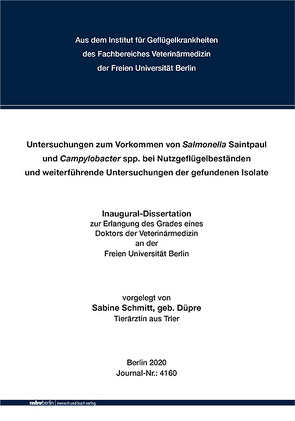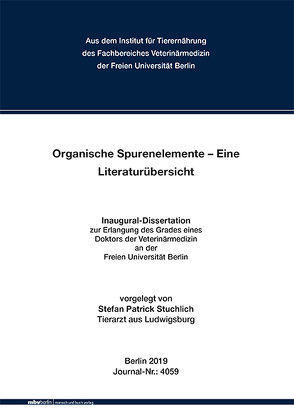
"Investigations on the occurence of Salmonella Saintpaul and Campylobacter spp. in poultry stocks and further investigations of the detected isolates"
The aim of this study was the evaluation of the samples, which were sent to the Institut für Geflügelkrankheiten of the Freie Universität Berlin from 2008 – 2011 because of statutory Salmonella investigation of poultry flocks. Further investigations were done with isolated Salmonella Saintpaul, which are one of the most often isolated serovars in turkeys. In 2013, S. Saintpaul has been the most often isolated serovar in fattening turkeys in the EU.
Also in this study, it was the most often isolated serovar in fattening turkeys from 2008 to 2010. In 2011 it was at 4th place after S. Infantis, S. Coeln and S. Typhimurium. S. Saintpaul can be a human pathogen and is frequently isolated from poultry meat samples, which is why we took a closer look at this serovar.
For further discrimation of the isolates a pulsed-field-gel-electrophoresis (PFGE) protocol was established. A total of 74 S. Saintpaul isolates were examined by PFGE, of which 67 isoaltes originated from fattening turkeys and seven from laying hens. Moreover 62 of the 74 isolates were tested for antimicrobial resistance. The resistance profiles were also used for discrimination. They widely matched with manual and computer analysis of the PFGE patterns.
Isolates matched from 35 – 100%, at which matching was higher the shorter the time between the sampling periods was.. Furthermore, there was a very high matching inbetween isolates from day-old-chicks over a timespan of four weeks, which were isolated from several flocks in Germany. This is most likely linked to the same origin of the chicks from the same breeder herds or via horizontal transmission at the hatchery. Unfortunately, the origin of the chicks in this study was unknown. We also found a very high match of isolates from day-oldchicks and laying hens. This indicates a common source of infection (i.e. wild birds, trucks, flock visitors, feed, etc.), what will not be solved without further investigation.
Another aim of this study was the attempt to isolate Campylobacter spp. from the samples sent to us due to statutory Salmonella investigation of poultry stocks. Till now there is no statutory provision for diagnosis of Campylobacter spp. in poultry stocks so we further investigated the method used in this study by other procedures.
First we performed isolation like in ISO 10727/2006 described, but instead of 10 ml of the Salmonella-preenrichement we only used 1 ml to not disturb the Salmonella diagnostics. We only found a prevalence of 18,1% in fattening turkeys and 9,4% in chickens. In fattening turkeys considerably more C. jejuni than C. coli were isolated, whereas in laying hens, it was more C. coli. This correlates to what was reported in the published literature. The very low prevalence instead contradicts the literature, why the isolation method was further checked.
Therefore we established a qantitative multiplex Realtime-Polymerase chain reaction (Multiplex qPCR). We investigated retained samples of the Salmonella preenrichement for the existence of Campylobacter-DNA. Here in 58,9% of the turkey samples and 96,3% of the laying hen samples Campylobacter-DNA was found. This is correlates to the literature.
It was noticed that the isolation results were worse the warmer the outside temperature had been. So we conducted storage trials to simulate the usual postal transportation of the Salmonella samples. Therefore, in the first trial we stored two different types of boot swabs for 30 Minutes, one day, two days, three days, four days and five days at different temperatures. Those swabs were scaled right after sampling and before testing to determine the weight loss. This weight loss was equalized with fluid loss. The weight loss unsurprisingly was higher the warmer the outside temperatures had been. We took a second standardized trial where we contaminated fecal samples of a negative laying hen flock with Campylobacter colonies and put the same amount of feces we found in trial one on the boot swabs. The swabs were again stored and investigated like in trial one.
The trials showed that the postal transportation is really disadvantageous for the isolation of Campylobacter spp. because of the oxidative stress for the bacteria, especially at high outside temperatures. A cooled transport to the laboratory is mandatory. If the cooling chain can be maintained the transportation can also endure longer than one day without compromising the isolation outcome.
Overall the isolation of Campylobacter spp. from the sent samples is not suitable for routine diagnostics. The Multiplex qPCR could be a reasonable alternative because of the rapidness of the method and the very low detection limit of Campylobacter-DNA. In addition in this study we further discriminated 54 C. jejuni isolates via sequencing of the Short Variable Region of the Flagellin A Gene (flaA-SVR). This showed a host specific as well as geographic relatedness. There was no time related relation.
Aktualisiert: 2022-12-31
> findR *

Organic trace elements – a review
The objective of the present review was to summarize the current state of knowledge on the use of organic trace elements in the livestock feed and to examine in what way organic trace elements based on terms of bioavailability and performance parameters, such as body weight development, retention in tissues and organs, immunity, reproduction and excretion considering the allowance ranges are distinct from conventional mineral trace element compounds. On the one hand, trace elements were examined for their function mechanisms, effect spectra and social significance, and on the other hand, current study results were compared with their effectiveness in consideration of the above reference values.
In addition to a brief sketching of the investigated elements copper, selenium, iron, zinc and manganese, the use of these elements in the legal framework as well as national and international supply recommendations were presented as a clear overview of the complex trace elements. Furthermore, in addition to a historical classification, organic trace elements were put into a current context, especially with regard to their production, chemical structure, bioavailability and resorption behavior. In chapter 11 the use of organic trace elements was collected in the current literature and summarized by species. In addition to the performance, the contents of the above five trace elements in excrement, blood and the concentration of these elements in organs and tissues were of particular interest. For the present work a total of 564 studies on organic trace elements in farm animals were evaluated. Taking into account the timeliness (not older than 30 years), the target species (pigs, poultry, cattle), the comparability of the studies (organic and inorganic study group), the trace elements (Zn, Mn, Cu, Fe, Se) and the examination parameters (supply area, bioavailability, immunity, reproduction, environment) remained a total of 173 studies, summarized in Chapter 11.
The literature research was carried out on the basis of the Cochrane guidelines and the required literature mostly could be downloaded online as a PDF file. These sources of literature have been incorporated into the literature management program Mendeley, which automatically reads author, year etc. from the files and can create text references by means of a MS Word plug-in. Furthermore, a search for catchwords within the literature selected as described above is possible, whereby cross-connections can be produced better and documented results by several research groups can be demonstrated.
The following conclusions were made:
• For organic trace elements, a number of positive effects are described which are mostly due to their chemical structure. In connection with this, there is often the indication of improved biological availability. The positive effects are partly due to increased retention in different organs or a more effective transition to offspring, eggs or milk. This can lead to an improved supply of the young animals.
• Another point of view is a more effective intermediate utilization, which manifests itself, for example, in an improved activity of different metalloenzymes and has positive influences on immune defense, reproduction, etc.
• When the trace element supply was carried out in the lower supply area, the trace elements from the organo compounds were usually more readily available than from mineral sources. The study results show that the use of organic trace element compounds in situations with suboptimal supply can have positive effects on performance parameters. This finding also applies to the incorporation of trace elements into the organs or tissues suitable for the indication.
• Through the use of smaller doses of organic trace elements, it is also possible to reduce the amount of trace element supplementation in various cases and thus to considerably reduce the discharge of trace elements via economic fertilizers.
• Although usualy the most cost-effective way to provide trace elements is the use of a highly available inorganic source of nutrients, the bioavailability of organic trace elements is often higher, which is why they are increasingly used in recent years. However, it is not completely scientifically determined whether this increase in bioavailability is accompanied by improved efficiency. Depending on species and study design, past studies could show the same, diminished or increased efficiency of organic versus mineral trace elements, with the majority of the investigated organic trace elements having equal efficiency.
Aktualisiert: 2019-12-31
> findR *
MEHR ANZEIGEN
Bücher zum Thema poultry
Sie suchen ein Buch über poultry? Bei Buch findr finden Sie eine große Auswahl Bücher zum
Thema poultry. Entdecken Sie neue Bücher oder Klassiker für Sie selbst oder zum Verschenken. Buch findr
hat zahlreiche Bücher zum Thema poultry im Sortiment. Nehmen Sie sich Zeit zum Stöbern und finden Sie das
passende Buch für Ihr Lesevergnügen. Stöbern Sie durch unser Angebot und finden Sie aus unserer großen Auswahl das
Buch, das Ihnen zusagt. Bei Buch findr finden Sie Romane, Ratgeber, wissenschaftliche und populärwissenschaftliche
Bücher uvm. Bestellen Sie Ihr Buch zum Thema poultry einfach online und lassen Sie es sich bequem nach
Hause schicken. Wir wünschen Ihnen schöne und entspannte Lesemomente mit Ihrem Buch.
poultry - Große Auswahl Bücher bei Buch findr
Bei uns finden Sie Bücher beliebter Autoren, Neuerscheinungen, Bestseller genauso wie alte Schätze. Bücher zum
Thema poultry, die Ihre Fantasie anregen und Bücher, die Sie weiterbilden und Ihnen wissenschaftliche
Fakten vermitteln. Ganz nach Ihrem Geschmack ist das passende Buch für Sie dabei. Finden Sie eine große Auswahl
Bücher verschiedenster Genres, Verlage, Autoren bei Buchfindr:
Sie haben viele Möglichkeiten bei Buch findr die passenden Bücher für Ihr Lesevergnügen zu entdecken. Nutzen Sie
unsere Suchfunktionen, um zu stöbern und für Sie interessante Bücher in den unterschiedlichen Genres und Kategorien
zu finden. Unter poultry und weitere Themen und Kategorien finden Sie schnell und einfach eine Auflistung
thematisch passender Bücher. Probieren Sie es aus, legen Sie jetzt los! Ihrem Lesevergnügen steht nichts im Wege.
Nutzen Sie die Vorteile Ihre Bücher online zu kaufen und bekommen Sie die bestellten Bücher schnell und bequem
zugestellt. Nehmen Sie sich die Zeit, online die Bücher Ihrer Wahl anzulesen, Buchempfehlungen und Rezensionen zu
studieren, Informationen zu Autoren zu lesen. Viel Spaß beim Lesen wünscht Ihnen das Team von Buchfindr.

